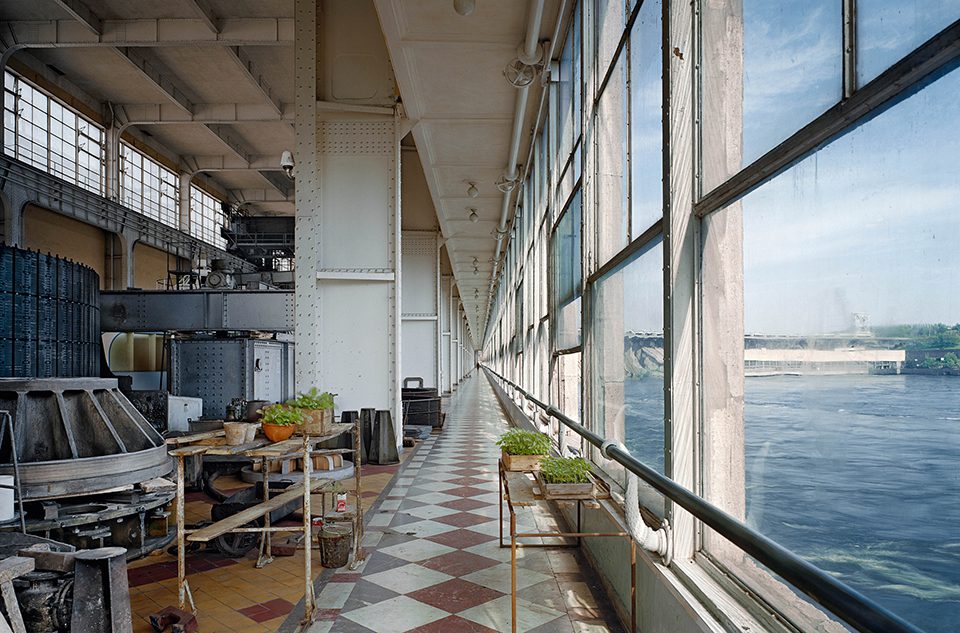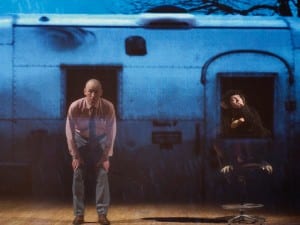In autumn 2011, a major survey explored a 20 year period in Soviet art and architecture at the Royal Academy of Arts in London.
Karl Marx famously stated in the preface to his 1859 A Contribution to the Critique of Political Economy: “It is not the consciousness of men that determines their being, but, on the contrary, their social being that determines their consciousness.” The idea that the social constructs and edifices of society necessarily determine the success and development of that society is intrinsic to the formation of the Soviet state after the 1917 Revolution. The economic foundations of the new socialist state were centred on the communal relationship of existence between each individual, hence the individual was literally expected to subsume themselves into the collective society – whether through communal living arrangements (kommunalka) or working environments. The establishment and development of new building types and an avant-garde language of architecture between the years 1915-1935 will be examined in an upcoming exhibition, Building the Revolution: Soviet Art and Architecture 1915-1935, to be staged at the Royal Academy of Arts, London.
The exhibition focuses on buildings designed and constructed within that revolutionary period: buildings that have, for the most part, fallen into various states of disrepair and disuse. Richard Pare (b. 1948), a contemporary photographer, has been photographing, documenting, and slowly building a visual archive of these structures over the past 20 years. Nicolai Ouroussoff once called Pare a “white Russian Knight” for his images which have brought to the public’s knowledge the run-down, somewhat shabby, urban remains that belie the extraordinary innovative skills of the architects who designed them. The exhibition (curated by Mary-Anne Stevens and Dr. Maria Tsantsanoglou) was in many ways a response to Pare’s images, as much as it was a decision to “place this architecture, for the first time, within the context of the innovative art created from 1914/15 which informed its formal language” as well as architecturally contextualise the buildings as they exist now in the urban environment. The juxtaposition of Pare’s images against images of the buildings as they looked at the time of their construction and their original designs, will visually articulate the disregard that many buildings are afforded as time passes. This exhibition follows on from MoMA’s 2007 exhibition Lost Vanguard: Soviet Modernist Architecture, 1922-32, which also looked at the architecture of the period as photographed by Pare, though the Royal Academy’s exhibition will be much more extensive and include drawings, periodicals, architectural renderings and models.
Pare straddles a difficult line as he is an artist, yet many of his photographs have in the past been exhibited as architectural renderings / documents, rather than as works of art. The process of documenting and archiving these designs and buildings within the art historical lineage of architecture is incredibly important, and thus it is perhaps not pertinent to begin a discussion on the qualities that some art historians and critics would use to determine art object versus document with regard to his work. The focus and intent of his images is that of capturing in time the structures as they stand, and in doing so there is a romantic aspect to every image that is undeniable – each building spelling out the hopes and desires of the architects who designed them. Unfortunately, these elements of design were ultimately quenched by Stalin who regarded the avant-garde and experimental as antithetical to the formal Stalinist Empire Style that he expounded.
The post-Revolutionary development of a new visual language and mode of aesthetic production was an amalgamation of several “isms”: Russian Futurism; Suprematism, and Constructivism. The dynamics of space, particularly as dictated by the geometry of the line, became of particular interest for many of the artists and architects of the period, as did the idea that need, rather than the aesthetics of beauty, was to dictate the new artistic foundations of the Soviet socialist state. These two strains of thought are elaborated upon at some length by Naum Gabo (1890-1977) and Antoine Pevsner (1886-1962) in their The Realistic Manifesto of 1920, in which they state: “We do not measure our works with the yardstick of beauty, we do not weigh them with pounds of tenderness and sentiments. The plumb-line in our hand, eyes as precise as a ruler, in a spirit as taut as a compass … we construct our work as the universe constructs its own, as the engineer constructs his bridges, as the mathematician his formula of orbits.” For Gabo and Pevsner the growth of a new civilisation and culture had to be tied into constructivist tendencies and rooted in necessity for it to survive and be successful.
The work of Konstantin Melnikov (1890-1974) is perhaps exemplary of this emphasis on geometry and the line. Melnikov, who designed worker’s clubs, garages, houses, and perhaps most famously the Russian Pavilion at the 1925 International Exhibition in Paris, was both innovative and playful in his work (two qualities which would eventually force the Soviet government to ban him from practising). His design for the Rusakov Worker’s Club (1929) demanded an architectural typology, which was triumphant, stimulating, and above all functional. The artistic vocabulary of the Soviet authorities demanded that art and architecture produced embodied these three adjectives, with architecture the visualisation of them into concrete form. Melnikov’s design for the worker’s club incorporated several rooms of varying size, which could be used together as a large auditorium, or as separate spaces. The building was constructed using concrete, brick and glass – perhaps not a conscious choice of material, but rather one dictated by a lack of materials (a factor which ultimately lent itself to the bare minimalist buildings of the period). There is a masculine energy inherent in Melnikov’s designs that can be seen in the work of the Vesnin Brothers as well: their buildings occupy space in a way that is incredibly definite without being overtly aggressive. The Vesnin Brothers Palace of Culture for the Shaumian Works (1929) is a statement in white of strong vertical lines with softly curved corners – a mastery of form and minimalism that is seen again in their design for the Likhachev Palace of Culture (1930). The Likhachev Palace was constructed as a public building, with a theatre, auditorium, library, and winter gardens, all of which were connected to allow the free movement of visitors within the space. This emphasis on collective movement was integral to many of the designs of the period.
Vladimir Tatlin (1885-1953) was fundamentally in opposition to Gabo and Pevsner, as the brothers propagated functionality as related to needs, whereas Tatlin was more intrigued by the adaptability of his designs than the actual functionality of them. Those buildings and structures not realised can be as important in terms of design and influence as those that were physically completed (in much the same way that haute couture filters down through the fashion world and back onto the high street, so too do the elaborate architectural drawings of famous architects and visual artists influence the practical spaces of living). Tatlin’s Monument to the Third International (1919) has never been physically realised according to the specifications of Tatlin’s design – a design which called for a 400-metre high tower to rotate on its own axis. The tower, consisting of four superimposed geometric volumes (a cube, a hemisphere, a pyramid and a cylinder), was meant to embody the dynamic architectonics of space that Tatlin had been fascinated with in his earlier spatial experiments: the cube was to turn one revolution a year; the pyramid once a month; and the cylinder once daily.
Smaller, less-ambitious models, such as that at the State Tretyakov Museum, Moscow, have been constructed to afford an aesthetic glimpse into the tower’s form and the various components that comprise its construction, and this exhibition will do the same. Jeremy Dixon Architects, a British based architectural firm, have been commissioned to construct a 10 metre version of Tatlin’s design. The firm previously built one, in 1971, as part of the Art and Revolution exhibition at the Hayward (albeit a smaller version at four metres) and thus it is fitting that they will once again have the opportunity to build a model of the monument. The tower’s design was a celebration of technology and progress as well as being a meditation on the idea of monuments as propaganda that exist in a constant state of flux – that is, being dependent on the society and environment that surrounds them. The traditional form of the public monument was meant to inspire and be a symbol of pride, patriotism, and morality, but this changed drastically during the 20th century, as artists and politicians alike realised the full propagandistic potential of the monument. The monument as figural statue was in demise and instead a new form of monument entered the pantheon – that of the architectural edifice, one that alluded to but did not outright declare its meaning.
The changing Soviet state required new buildings, as well as the transformation of pre-existing ones, and a programme of construction was thus implemented. Factories, government offices, power stations and dams, workers’ housing and communal housing became popular, especially new residential flats which physically altered the living spaces of tenants who were forced to interact with one another in a way that had perhaps not been seen to such an extent before. This is exemplified by the Narkomfin Building, a block of flats in Moscow designed by Moises Ginsburg and Ignaty Milinis (1928-32) for the workers at the Commissariat of Finance. The building is now, like so many buildings from the period, in a state of disrepair, but at its apogee it was a streamlined concrete building consisting of a series of flats, each classified according to its varying degree of “collectivised” status (i.e. how communal each living space was). The building offered communal kitchens, a crèche, and a laundry, so that save for the actual personal “living” areas, most were forced to share the functionally optimised facilities. Narkomfin still stands today, but is in such a state of dis-repair that only about 80% of it is habitable – if that.
The construction of workers’ housing is not in itself revolutionary or novel but rather, as Tsantsanoglou points out, it was “the imposition of social change through the introduction of communal housing” which was innovative. The Narkomfin building’s influence can be seen to this day, perhaps most famously in Le Corbusier’s Unite d’Habitation. Post-war Marseille was similar to the post-revolution Soviet state – densely inhabited and over-crowded – and Corbusier’s design was closely inspired by Ginsburg and Milinis’, using communal spaces to counteract the inadequacy of smaller living spaces, in order to house as many individuals in as reduced a space as possible. The influence of Russian architects upon the “western” world has been only touched upon briefly in art historical texts, and this exhibition, in particular an essay by Jean-Louis Cohen in the exhibition catalogue, will expound upon this.
The new socialist society required a novel programme of art and architecture to support its ideas of social change and revolution. The historical buildings of the past were no longer sufficient or adequate and served only to remind the individuals of their past, preventing them from looking forward to the future and aspiring to a new collective society. Thus the ingenuity of design that appeared during this period is important to document and remember, as it was created and used as an agent for social change. Whether the artists and architects of the period were successful remains to be seen, as they were never given a chance to see the outcome of the utopian future they envisaged through their buildings, as Stalin stepped in and ended this fertile period of architectural design. Unfortunately in the current post-Soviet capitalist society, many developers have neither knowledge for understanding of what these buildings represent and many of them have been destroyed already: in a way they stand as the ruins of an ancient society; one which is sadly not that ancient.
Building the Revolution: Soviet Art and Architecture 1915-1935 opened 29 October and continued until 22 January 2012. www.royalacademy.org.uk
Niamh Coghlan





